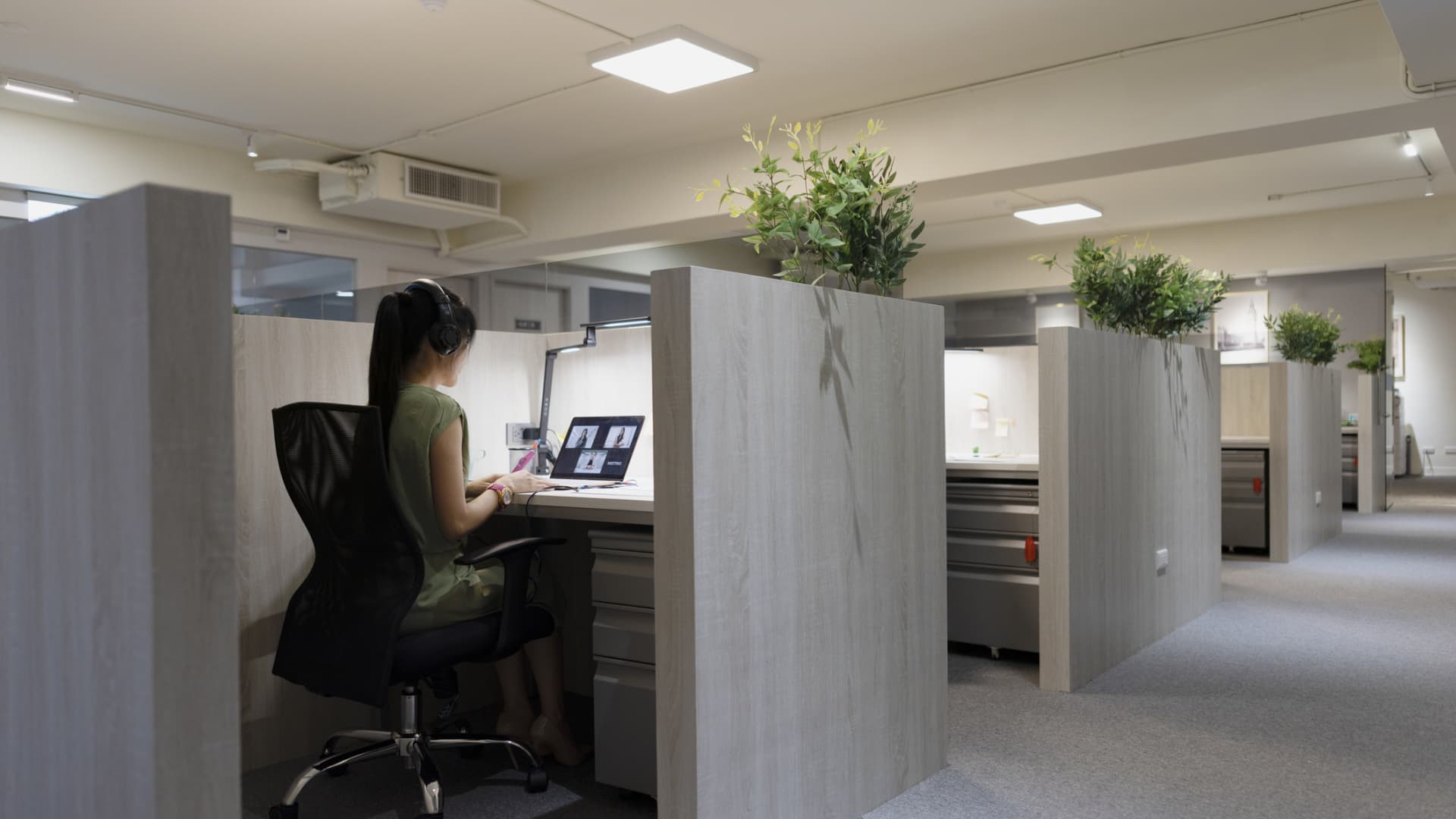Why the return to the office isn’t working
“I don’t gain anything besides a commute.”
Andres is back to the office three days a week, and like many knowledge workers, he’s not happy about it. He says that while he and the other executive assistants at his Boston law firm have been forced back, the attorneys haven’t been following the rules. That’s partly because the rules don’t quite make sense, and people in all types of jobs are only coming in because they have to, not because there’s a good reason to go in.
“People have adapted to remote work, and truthfully, the firm has done a tremendous job at adapting in the pandemic,” said Andres, who would prefer going in two days, as long as others were actually there. “But I think it’s more the returning to work that they’re struggling on.” He, like a number of other office workers, spoke with Recode anonymously to avoid getting in trouble with his employer.
Andres enjoys working from home and thinks he does a good job of it — and it allows him to escape a long commute that has only gotten 45 minutes longer thanks to construction projects on his route.
The majority of Americans don’t work from home, but among those who do, there’s a battle going on about where they’ll work in the future. And it’s not just people who enjoy remote work who are upset about the return to the office.
Those who want to be remote are upset because they enjoyed working from home and don’t understand why, after two years of doing good work there, they have to return to the office. People who couldn’t wait to go back are not finding the same situation they enjoyed before the pandemic, with empty offices and fewer amenities. Those who said they prefer hybrid —
60 percent of office workers — are not always getting the interactions with colleagues they’d hoped for.
The reasons the return to the office isn’t working out are numerous. Bosses and employees have different understandings of what the office is for, and after more than two years of working remotely, everyone has developed their own varied expectations about how best to spend their time.
As more and more knowledge workers return to the office, their experience at work — their ability to focus, their stress levels, their level of satisfaction at work — has deteriorated. That’s a liability for their employers, as the rates of job openings and quits are near record highs for professional and business services, according to
Bureau of Labor Statistics data.
There are, however, ways to make the return to the office better, but those will require some deep soul-searching about why employers want employees in the office and when they should let it go.
The current situation
For now, many employees are just noticing the hassle of the office, even if they’re going in way less than they did pre-pandemic.
This is what’s known as the hybrid model, and even though people like the remote work aspect of it, for many it’s still unclear what the office part of it is for.
“If I go into the office and there are people but none of them are on my team, I don’t gain anything besides a commute,” Mathew, who works at a large payroll company in New Jersey, said. “Instead of sitting at my own desk, I’m sitting at a desk in Roseland.”
Mathew’s company is asking people to come in three days a week, but he says people are mostly showing up two.
Further complicating things is that, while the main reason hybrid workers cite for wanting to go into the office is to see colleagues, they also don’t want to be told when to go in, according to Nicholas Bloom, a Stanford professor who, along with other academics, has been conducting a large, ongoing study of remote workers called
WFH Research.
Employees say that management has yet to really penalize people for failing to follow office guidance, likely out of fear of alienating a workforce in a climate where it’s so hard to hire and retain employees. Many others moved
farther from the office during the pandemic, making the commute harder. The result is circular: People go into the office to see other people but then don’t actually see those people so they stop going into the office as much.
With
70 percent of office workers globally now back in the office at least one day a week, the excitement many people felt a few months ago is wearing off. For many, that novelty is turning into an existential question: Why are we ever here?
“It was sort of like the first day of school when you’re back from summer vacation and it’s nice to see people and catch up with them,” Brian Lomax, who works at the Department of Transportation in Washington, DC and who is expected to come in two days a week, said. “But now it’s, ‘Oh, hey, good to see you,’ and then you go on about your day,” an experience he says is the same as working from home and reaching out to people via Microsoft Teams.
There’s actually been an uptick in virtual meetings, despite the return to office
Most of the people we spoke to use software like Teams, Slack, and Zoom to communicate even while they’re in the office, making the experience similar to home. If one person in a meeting is on a video call from home — say, because they’re immunocompromised, or they have child care duties, or it just happens to be the day they work from home that week — everyone is.
There’s actually been an uptick in virtual meetings, despite the return to the office, according to Calendly. In April, 64 percent of meetings set up through the appointment scheduling software included videoconferencing or phone details, compared with 48 percent a year earlier.
One issue is that hybrid means different things from company to company and even team to team. Typically, it seems employers are asking workers to come in a set number of days per week, usually two or three. Some employers are specifying which days; some are doing it by teams; some are leaving it up to individual workers. Almost half of office visits are just once a week — and over a third of these visits are for less than six hours, according to data from workplace occupancy analytics company
Basking.io as reported by Bloomberg. The middle of the week tends to be much busier than Mondays and Fridays, when there are empty cubicles as far as the eye can see.
There’s also a disconnect between why employees think they’re being called in.
Employees cite their company’s sunk real estate investments, their bosses’ need for control, and their middle managers’ raison d’etre. Employers, meanwhile, think going into the office is good for
creativity, innovation, and culture building. Nearly 80 percent of employees think they’ve been just as or
more productive than they were before the pandemic, while less than half of leaders think so, according to
Microsoft’s Work Trends Index.
Employers and employees generally tend to agree that a good reason to go into the office is to see colleagues face to face and onboard new employees.
Data from Time Is Ltd. found that employees that started during the pandemic are collaborating with less than 70 percent of colleagues and clients as their tenured peers would have been at this point. Slack’s
Future Forum survey found that while executives were more likely to say people should come into the office full time, they are less likely to do so themselves.
The nature of individuals’ jobs also determines how much, if at all, they think they should be in the office. Melissa, a government policy analyst in DC, is supposed to go in twice a week but has only been going in once because she says her work involves collaborating with others but not usually at the same time. She might write a draft, send it to others to read, and then they’ll make comments and perhaps, at some point, they all get together to talk about it.
“I see a lot of these ads for these teamwork apps — they always show these pictures of people sitting at a conference table and they have paper and all sorts of things on the wall and they’re really collaborating on product development or something,” Melissa said. “And I’m like, that’s not what we’re doing.” Still, she thinks that from managers’ perspectives, in-person is the gold standard, regardless of the actualities of the job.
“It feels like they just want people in the office,” she said.
It also depends on the pace of work. A financing services employee at Wells Fargo in Iowa said he works more efficiently at the office but that since his job consists of working on deals that come in sporadically throughout the day, that efficiency means he ends up wasting a lot of time playing on his phone or pacing around the office in between.
“What makes this so frustrating is that my wife will send me a photo of her and my 10-month-old son going out for a walk,” he said. “If I had a break at home, I’d go on a walk with them.”
Employers are certainly feeling the frustration from their employees and have been walking back how much they’re asking employees to be in the office. Last summer, office workers reported that their employers would allow them to work from home 1.6 days a week; now that’s gone up to 2.3 days, according to WFH Research.
Companies are rolling back return-to-office, or RTO, plans at
law firms,
insurance agencies, and
everywhere in between. Even finance companies like JPMorgan Chase, whose CEO has been especially vocal about asking people to return to their offices,
have loosened up.
Tech companies have long been at the forefront when it comes to allowing hybrid or remote work, and now even more tech companies, including Airbnb,
Cisco, and Twitter, are joining the club. Even
Apple, which has been much stricter than its peers in coaxing employees back to the office, has
paused its plan to increase days in the office to three a week, after
employee pushback and the
resignation of a prominent machine learning engineer.
It seems like, for now, office workers have the upper hand. Many don’t expect to be penalized by management for not working from the office when they’re supposed to, partly because they don’t think management believes in the rules themselves.
“Our retention is better than expected and our employee engagement is better than expected, so I don’t think [our executives are] seeing any downside,” said Rob Carr, who works at an insurance company in Columbus, Ohio, where people are expected to be in three days a week but, as far as he’s seen, rarely go. “Honestly, if they were, I think they’d be cracking down, and they’re not.”
Carr himself goes into the office every day, but only because he and his wife downsized houses and moved a short bike ride from his office. Otherwise Carr, who is on the autism spectrum and says he doesn’t do well with in-person interactions, would be completely happy working from home as he is from his empty office.
“Hats off to Apple for innovation,” Carr said, “but they are, certainly from a Silicon Valley perspective, an old company.”
What to do about the broken return to the office
Solving the office conundrum is not easy, and in all likelihood it will be impossible to make everyone happy. But it’s important to remember that going to the office
never really worked for everyone, it was just what everyone did. Now, two years after the pandemic sent office workers to their living rooms, their employers may have a chance to make more people happy than before.
“The problem right now is you’ve set something that’s unrealistic and doesn’t work, and when employees try it out and it doesn’t work, they give up,” Bloom, the Stanford professor, said. “If employees refuse to come in, it means the system isn’t working.”
“If employees refuse to come in, it means the system isn’t working”
To fix that, employers should explore not only why they want people in the office, but whether bringing people into the office is achieving those goals. If the main reason to bring people back is to collaborate with colleagues, for example, they need to set terms that ensure that happens. That could mean making people who should be working together come in on the same days — a problem around which a whole
cottage industry of remote scheduling software has cropped up.
That said, Bloom believes there’s no golden rule on how often it’s necessary to go in to get the benefits of the office. Importantly, when workers do come in, they shouldn’t be bogged down with anything they could be doing at home.
“First, figure out how many days a week or a month constructively would it be good to have people face to face, and that depends on how much time you spend on activities that are best in person,” he said, referring to things like onboarding, training, and socializing.
Employers need to be realistic about how much in-person work really needs to happen. Rather than making people come in a few times a week at random, where colleagues pass like ships in the night, they could all come in on the same day of the week or even once a month or quarter. And on those days, the perks of coming in have to be more than
tacos and T-shirts, too. While fun,
free food and swag aren’t actually good reasons to go to the office.
How much someone needs to come into the office might also vary by team or job type.
“For me, coming in to do teaching and to go to research seminars, that might be twice a week,” Bloom said. “But for other people, like coders, it may just be a big coding meeting and a few trainings once a month. For people in marketing and advertising, mad men, that’s very much around meetings, discussions, problem-solving — that may be two or three days.”
Another thing to consider, especially for those who truly like the office, is how they can get that experience with fewer of the downsides.
Currently, even employees who still like their offices a lot aren’t necessarily using them. Real estate services company JLL found that a third of office workers are using so-called “third places” like cafes and coworking spaces to work, even when they have offices they can go to.
Matt Burkhard, who leads a team of 30 at Flatiron Health, is one of those workers. He says he works better at an office than at home, where he has two young children. And while Burkhard enjoys going into his office and goes there once or twice per week, though he won’t be required to do so until later this summer, the trip to Manhattan isn’t always feasible, especially if he has to do child care for part of the day. So he’s been going to
Daybase, a coworking space near his home in Hoboken, NJ, three or four times per week.
“I’m just a lot more focused when everyone is in the same place working,” Burkhard said, noting that he hasn’t asked his company to pay for the $50 a month membership fee.
For many office workers, the current state of affairs just isn’t working out. So they’re doing what they can to make their experience of work better, whether that means renting coworking space or not showing up for arbitrary in-office days. They don’t necessarily hate the office. What they hate is not having a good reason to be there.
“I don’t gain anything besides a commute.”

www.vox.com



 Their entire identities are tied to the only thing they think they are good at and that people will listen to them on. They live for correcting people on that job or for questions that need to be answered. That's their power. At home, nothing.
Their entire identities are tied to the only thing they think they are good at and that people will listen to them on. They live for correcting people on that job or for questions that need to be answered. That's their power. At home, nothing. ) a 10% increase to stop the bleeding AND told the ones who got the raises not to tell the ones who didn't.
) a 10% increase to stop the bleeding AND told the ones who got the raises not to tell the ones who didn't.


